Bibliometric Analysis of the Research on the Impact of Environmental Regulation on Green Technology Innovation Based on CiteSpace
Abstract
1. Introduction
2. Literature Review
3. Data Sources and Research Method
3.1. Data Source
3.2. Research Method
4. Analysis of the Impact of Environmental Regulation on Green Technology Innovation
4.1. Analysis of the Annual Number of Publications
4.2. Analysis of the Authors of Literature
4.3. Analysis of Literature Publishing Institutions
4.4. Distribution of Countries (Regions) with Research Findings
4.5. Journal Distribution of Available Research
5. Analysis of Research Hotspots
5.1. Keyword Co-Occurrence Analysis
5.2. Cluster Analysis of Keywords
5.3. Timeline Mapping Analysis
6. Evolution of Research Themes and Trends
6.1. Thematic Chronological Evolution
6.2. Analysis of Burst Words
7. Conclusions and Recommendations
7.1. Conclusions
7.2. Recommendations
7.3. Limitations
7.4. Future Study
Author Contributions
Funding
Institutional Review Board Statement
Informed Consent Statement
Data Availability Statement
Acknowledgments
Conflicts of Interest
References
- Li, X.A. Environmental Regulation, Government Subsidies and Regional Green Technology Innovation. Econ. Surv. 2021, 38, 14–23. [Google Scholar] [CrossRef]
- Wang, M.Y.; Li, Y.M.; Wang, Z.T. Heterogeneity Analysis of the Impact of Environmental Regulation on Green Technology Innovation of Enterprises—Based on Large Sample Data of Industrial Enterprises in China. Inq. Econ. Issues 2022, 67–81. [Google Scholar]
- Zhang, W.Q.; Chen, Y.K. Research on the Impact of Environmental Regulation Tools and R&D Subsidies on Green Technology Innovation. Ecol. Econ. 2022, 38, 36–46. [Google Scholar]
- Porter, M.E. America’s Green Strategy. Sci. Am. 1991, 264, 193–246. [Google Scholar]
- Porter, M.E.; Linde, C. Toward a New Conception of the Environment-Competitiveness Relationship. J. Econ. Perspect. 1995, 9, 97–118. [Google Scholar] [CrossRef]
- Yuan, Y.J.; Chen, Z. Environmental regulation, green technology innovation and the transformation and upgrading of China’s manufacturing industryn. Stud. Sci. Sci. 2019, 37, 1902–1911. [Google Scholar] [CrossRef]
- Xiao, L.M.; Gao, J.F.; Liu, S. The Change Trend of Green Technology Innovation Efficiency in China Based On Spatial Gradient—Empirical Analysis of Provincial Panel Data. Soft Sci. 2017, 31, 63–68. [Google Scholar] [CrossRef]
- Lanoie, P.; Patry, M.; Lajeunesse, R. Environmental regulation and productivity: Testing the porter hypothesis. J. Product. Anal. 2008, 30, 121–128. [Google Scholar] [CrossRef]
- Li, W.H.; Li, N.; Liu, F. Three Parties’ Evolutionary Game of Stakeholders in Green Technology Innovation and Their Simulation. Oper. Res. Manag. Sci. 2021, 30, 216–224. [Google Scholar] [CrossRef]
- Deng, Y.P.; Wang, L.; Zhou, W.J. Does Environmental Regulation Promote Green Innovation Capability?—Evidence from China. Stat. Res. 2021, 30, 216–224. [Google Scholar]
- Liu, J.K.; Xiao, Y.Y. China’s Environmental Protection Tax and Green Innovation: Incentive Effect or Crowding-out Effect? Econ. Res. J. 2022, 57, 72–88. [Google Scholar]
- Barbieri, N. Fuel prices and the invention crowding out effect: Releasing the automotive industry from its dependence on fossil fuel. Technol. Forecast. Soc. Change 2016, 111, 222–234. [Google Scholar] [CrossRef]
- Leeuwen, G.; Mohnen, P. Revisiting the Porter hypothesis: An empirical analysis of Green innovation for the Netherlands. Econ. Innov. New Technol. 2017, 26, 63–77. [Google Scholar] [CrossRef]
- Yang, Q.Y.; Gao, D.; Song, D.Y.; Li, Y. Environmental regulation, pollution reduction and green innovation: The case of the Chinese Water Ecological Civilization City Pilot policy. Econ. Syst. 2021, 45, 100911. [Google Scholar] [CrossRef]
- Song, X.N.; Xue, H.F. Environmental regulation, FDI spillovers and green technology innovation in manufacturing. Stat. Decis. 2022, 38, 81–85. [Google Scholar] [CrossRef]
- Yuan, B.L.; Ren, S.G.; Chen, X.H. Can environmental regulation promote the coordinated development of economy and environment in China’s manufacturing industry?—A panel data analysis of 28 sub-sectors. J. Clean. Prod. 2017, 149, 11–24. [Google Scholar] [CrossRef]
- Sun, Y.M.; Shen, S.M. The spatio-temporal evolutionary pattern and driving forces mechanism of green technology innovation efficiency in the Yangtze River Delta region. Geogr. Res. 2021, 40, 2743–2759. [Google Scholar] [CrossRef]
- Li, Q.Y.; Xiao, Z.H. Heterogeneous Environmental Regulation Tools and Green Innovation Incentives: Evidence from Green Patents of Listed Companies. Econ. Res. J. 2020, 55, 192–208. [Google Scholar]
- Bergek, A.; Berggren, C.; KITE Research Group. The impact of environmental policy instruments on innovation: A review of energy and automotive industry studies. Ecol. Econ. 2014, 106, 112–123. [Google Scholar] [CrossRef]
- Liang, M.; Cao, H.J.; Chen, Z.W. Environmental Regulation, Environmental Responsibility and Enterprise Green Technological lnnovation. Enterp. Econ. 2021, 40, 15–23. [Google Scholar] [CrossRef]
- Xiong, G.Q.; Shi, D.Q.; Li, M.N. The effect of low-carbon pilot cities on the green technology innovation of enterprises. Sci. Res. Manag. 2020, 41, 93–102. [Google Scholar] [CrossRef]
- Palmer, K.; Oates, W.; Portney, O. Tightening Environmental Standards: The Benefit-Cost or the No-Cost Paradigm? J. Econ. Perspect. 1995, 9, 119–132. [Google Scholar] [CrossRef]
- Ramanathan, R.; Black, A.; Nath, P.; Muyldermans, L. Impact of environmental regulations on innovation and performance in the UK industrial sector. Manag. Decis. 2010, 48, 1493–1513. [Google Scholar] [CrossRef]
- Hou, J.; Chen, H. Research on the Green Technological Innovation Performance and Driving Factors of High Patent-intensive Manufacturers in China. Manag. Rev. 2018, 30, 59–69. [Google Scholar] [CrossRef]
- Gong, Y.Y.; Liu, Z.S. Financial Structure and Green Technological Progress: Theoretical Model, Influencing Effect and Action Mechanisms. Econ. Surv. 2021, 38, 151–160. [Google Scholar] [CrossRef]
- Wang, P.; Dong, C.; Chen, N.; Qi, M.; Yang, S.C.; Nnenna, A.B.; Li, W.X. Environmental Regulation, Government Subsidies, and Green Technology Innovation—A Provincial Panel Data Analysis from China. Int. J. Environ. Res. Public Health 2021, 18, 11991. [Google Scholar] [CrossRef]
- Guo, Y.Y.; Xia, X.N.; Zhang, S.; Zhang, D.P. Environmental Regulation, Government R&D Funding and Green Technology Innovation: Evidence from China Provincial Data. Sustainability 2018, 10, 940. [Google Scholar] [CrossRef]
- Cecere, G.; Corrocher, N. Stringency of regulation and innovation in waste management: An empirical analysis on EU countries. Ind. Innov. 2016, 23, 625–646. [Google Scholar] [CrossRef]
- Tang, J.; Li, S.L. How Do Environmental Regulation and Environmental Decentralization Affect Regional Green Innovation? Empirical Research from China. Int. J. Environ. Res. Public Health 2022, 19, 7074. [Google Scholar] [CrossRef]
- Chen, Y.K.; Liu, L.T.; Dong, J.R. Regional differences in environmental regulation tools and green technology innovation—Analysis of Chinese provincial dynamic panel data based on system GMM and dynamic threshold. Sci. Res. Manag. 2021, 43, 1–13. [Google Scholar] [CrossRef]
- Dong, J.R.; Zhang, W.Q.; Chen, Y.K. The impact of environmental regulation tools and government support on green technological innovation. Ind. Econ. Res. 2021, 1–16. [Google Scholar] [CrossRef]
- Liu, J.J.; Zhao, M.; Wang, Y.B. Impacts of government subsidies and environmental regulations on green process innovation: A nonlinear approach. Technol. Soc. 2020, 63, 101417. [Google Scholar] [CrossRef]
- Petroni, G.; Bigliardi, B.; Galati, F. Rethinking the Porter Hypothesis: The Underappreciated Importance of Value Appropriation and Pollution Intensity. Rev. Policy Res. 2019, 36, 121–140. [Google Scholar] [CrossRef]
- Sun, Z.L.; Zhu, D.M. Investigating environmental regulation effects on technological innovation: A meta-regression analysis. Energy Environ. 2021. [Google Scholar] [CrossRef]
- Pan, X.; Cheng, W.Y.; Gao, Y.N.; Balezentis, T.; Shen, Z.Y. Is environmental regulation effective in promoting the quantity and quality of green innovation? Environ. Sci. Pollut. Res. 2021, 28, 6232–6241. [Google Scholar] [CrossRef] [PubMed]
- Brunnermeier, S.B.; Cohen, M.A. Determinants of environmental innovation in US manufacturing industries. J. Environ. Econ. Manag. 2003, 45, 278–293. [Google Scholar] [CrossRef]
- Tu, Z.G.; Shen, R.J. Can Emissions Trading Scheme Achieve the Porter Effect in China? Econ. Res. J. 2015, 50, 160–173. [Google Scholar]
- Lovely, M.; Popp, D. Trade, technology, and the environment: Does access to technology promote environmental regulation? J. Environ. Econ. Manag. 2011, 61, 16–35. [Google Scholar] [CrossRef]
- Yan, X.Y.; Jin, X.; Tong, T.J. Research Hotspots and Development of Environmental Regulation in China—Visual Analysis Based on CNKI. Jiangxi Soc. Sci. 2019, 39, 99–110. [Google Scholar]
- Yang, R.; Duan, Z.W.; Du, M.J.; Miao, X. A Comprehensive Knowledge Pedigree on Environmental Transparency. Pol. J. Environ. Stud. 2020, 30, 535–554. [Google Scholar] [CrossRef]
- Bian, M.Y.; Yu, H.X.; Zhang, Y.X. Research Trend and Perspectives on China’s Green Innovation: Analysis Based on Bibliometrics and Knowledge Graph. Sci. Technol. Manag. Res. 2020, 40, 236–243. [Google Scholar] [CrossRef]
- Xia, S.L.; Zhong, K.Y. Knowledge Mapping of Green Technology Visualization with Bibliometric Tools. Sci. Program. 2021, 2021, 6298813. [Google Scholar] [CrossRef]
- Shen, N.; Hu, Y.S.; Peng, H. Can environmental regulation stimulate green innovation? China Popul. Resour. Environ. 2020, 30, 75–84. [Google Scholar]
- Li, X.W.; Long, H.Y. Research Focus, Frontier and Knowledge Base of Green Technology in China: Metrological Research Based on Mapping Knowledge Domains. Pol. J. Environ. Stud. 2020, 29, 3003–3011. [Google Scholar] [CrossRef]
- Liu, C.C.; Deng, C.X.; Li, Z.W.; Liu, Y.J.; Wang, S.Y. Optimization of Spatial Pattern of Land Use: Progress, Frontiers, and Prospects. Int. J. Environ. Res. Public Health 2022, 19, 5805. [Google Scholar] [CrossRef]
- Nascimento, H.; Martinez-Perez, C.; Alvarez-Peregrina, C.; Sanchez-Tena, M.A. Citations Network Analysis of Vision and Sport. Int. J. Environ. Res. Public Health 2020, 17, 7574. [Google Scholar] [CrossRef]
- Chen, Y.; Chen, C.M.; Liu, Z.Y.; Hu, Z.G.; Wang, X.W. The methodology function of Cite Space mapping knowledge domains. Stud. Sci. Sci. 2015, 33, 242–253. [Google Scholar] [CrossRef]
- Chen, C. CiteSpace Ⅱ: Detecting and visualizing emerging trends and transient patterns in scientific literature. J. Am. Soc. Inf. Sci. Technol. 2006, 57, 359–377. [Google Scholar] [CrossRef]
- Chen, C.; Ibekwe- SanJuan, F.; Hou, J. The structure and dynamics of co-citation clusters: A multiple-perspective co-citation analysis. J. Am. Soc. Inf. Sci. Technol. 2010, 61, 1386–1409. [Google Scholar] [CrossRef]
- D’Amato, A.; Mazzanti, M.; Nicolli, F. Green Technologies and Environmental Policies for Sustainable Development: Testing Direct and Indirect Impacts. J. Clean. Prod. 2021, 309, 127060. [Google Scholar] [CrossRef]
- Stucki, T.; Woerter, M.; Arvanitis, S.; Peneder, M.; Rammer, C. How different policy instruments affect green product innovation: A differentiated perspective. Energy Policy 2018, 114, 245–261. [Google Scholar] [CrossRef]
- Stucki, T.; Woerter, M. Intra-firm diffusion of green energy technologies and the choice of policy instruments. J. Clean. Prod. 2016, 131, 545–560. [Google Scholar] [CrossRef]
- Johnstone, N.; Hascic, I.; Popp, D. Renewable Energy Policies and Technological Innovation: Evidence Based on Patent Counts. Environ. Resour. Econ. 2010, 45, 133–155. [Google Scholar] [CrossRef]
- Ambec, S.; Cohen, M.A.; Elgie, S.; Lanoie, P. The Porter Hypothesis at 20: Can Environmental Regulation Enhance Innovation and Competitiveness? Rev. Environ. Econ. Policy 2013, 7, 2–22. [Google Scholar] [CrossRef]
- Guo, R.; Lv, S.; Liao, T.; Xi, F.; Zhang, J.; Zuo, X.T.; Cao, X.J.; Feng, Z.; Zhang, Y.L. Classifying green technologies for sustainable innovation and investment. Resour. Conserv. Recycl. 2020, 153, 104580. [Google Scholar] [CrossRef]
- Goulden, S.; Negev, M.; Reicher, S.; Berman, T. Implications of standards in setting environmental policy. Environ. Sci. Policy 2019, 98, 39–46. [Google Scholar] [CrossRef]
- Runhaar, H.; Driessen, P.; Uittenbroek, C. Towards a Systematic Framework for the Analysis of Environmental Policy Integration. Environ. Policy Gov. 2014, 24, 233–246. [Google Scholar] [CrossRef]
- Amowine, N.; Ma, Z.Q.; Li, M.X.; Zhou, Z.X.; Naminse, E.Y.; Amowine, J. Measuring Dynamic Energy Efficiency in Africa: A Slack-Based DEA Approach. Energy Sci. Eng. 2020, 8, 3854–3865. [Google Scholar] [CrossRef]
- Amowine, N.; Ma, Z.Q.; Li, M.X.; Zhou, Z.X.; Asunka, B.A.; Amowine, J. Energy Efficiency Improvement Assessment in Africa: An Integrated Dynamic DEA Approach. Energies 2019, 12, 3915. [Google Scholar] [CrossRef]
- Li, X.W.; Dai, J.C.; Shen, Q. What Is the Mechanism of Government Green Development Behavior Considering Multi-Agent Interaction? A Meta-Analysis. Int. J. Environ. Res. Public Health 2022, 19, 8263. [Google Scholar] [CrossRef]
- Deng, Y.L.; You, D.M.; Wang, J.J. Optimal strategy for enterprises’ green technology innovation from the perspective of political competition. J. Clean. Prod. 2019, 235, 930–942. [Google Scholar] [CrossRef]
- Ghisetti, C.; Pontoni, F. Investigating policy and R&D effects on environmental innovation: A meta-analysis. Ecol. Econ. 2015, 118, 57–66. [Google Scholar] [CrossRef]
- Kivimaa, P.; Mickwitz, P. The challenge of greening technologies—Environmental policy integration in Finnish technology policies. Res. Policy 2006, 35, 729–744. [Google Scholar] [CrossRef]
- Engel-Cox, J.A.; Hoff, R.M. Science–policy data compact: Use of environmental monitoring data for air quality policy. Environ. Sci. Policy 2005, 8, 115–131. [Google Scholar] [CrossRef]
- Joo, H.Y.; Suh, H. The Effects of Government Support on Corporate Performance Hedging against International Environmental Regulation. Sustainability 2017, 9, 1980. [Google Scholar] [CrossRef]
- Zhang, J.D.; Qu, X.Y.; Sangaiah, A.K. A Study of Green Development Mode and Total Factor Productivity of the Food Industry Based on the Industrial Internet of Things. IEEE Commun. Mag. 2018, 56, 72–78. [Google Scholar] [CrossRef]
- Ong, T.S.; Lee, A.S.; Teh, B.H.; Magsi, H.B. Environmental Innovation, Environmental Performance and Financial Performance:Evidence from Malaysian Environmental Proactive Firms. Sustainability 2019, 11, 12. [Google Scholar] [CrossRef]
- Xue, B.; Zhang, Z.; Li, P.L. Corporate environmental performance, environmental management and firm risk. Bus. Strategy Environ. 2020, 29, 1074–1096. [Google Scholar] [CrossRef]
- Usman, M.; Ma, Z.Q.; Zafar, M.W.; Waheed, A.; Li, M.X. Analyzing the determinants of clean energy consumption in a sustainability strategy: Evidence from EU-28 countries. Environ. Sci. Pollut. Res. 2021, 28, 54551–54564. [Google Scholar] [CrossRef]
- Zhang, M.J.; Anaba, O.A.; Ma, Z.Q.; Mingxing, L.; Asunka, B.A.; Hu, W. En route to attaining a clean sustainable ecosystem: A nexus between solar energy technology, economic expansion and carbon emissions in China. Environ. Sci. Pollut. Res. 2020, 27, 18602–18614. [Google Scholar] [CrossRef]
- Ospanova, A.; Popovychenko, I.; Chuprina, E. Green Economy-Vector of Sustainable Development. Probl. Ekorozw. 2022, 17, 171–181. [Google Scholar] [CrossRef]
- Lam, J.S.L.; Li, K.X. Green port marketing for sustainable growth and development. Transp. Policy 2019, 84, 73–81. [Google Scholar] [CrossRef]
- Tortorella, M.M.; Di, L.S.; Cosmi, C.; Fortes, P.; Viccaro, M.; Cozzi, M.; Pietrapertosa, F.; Salvia, M.; Romano, S. A Methodological Integrated Approach to Analyse Climate Change Effects in Agri-Food Sector: The TIMES Water-Energy-Food Module. Int. J. Environ. Res. Public Health 2020, 17, 7703. [Google Scholar] [CrossRef] [PubMed]
- Wang, M.Y.; Li, Y.M.; Wang, Z.T.; Li, J.Q. The Heterogeneous Relationship between Pollution Charges and Enterprise Green Technology Innovation, Based on the Data of Chinese Industrial Enterprises. Energies 2022, 15, 1663. [Google Scholar] [CrossRef]
- Wang, M.X.; Liu, P.; Gu, Z.L.; Cheng, H.; Li, X. A Scientometric Review of Resource Recycling Industry. Int. J. Environ. Res. Public Health 2019, 16, 4654. [Google Scholar] [CrossRef]
- Jia, B.Y.; Chen, Y.T.; Wu, J. Bibliometric Analysis and Research Trend Forecast of Healthy Urban Planning for 40 Years (1981–2020). Int. J. Environ. Res. Public Health 2021, 18, 9444. [Google Scholar] [CrossRef]
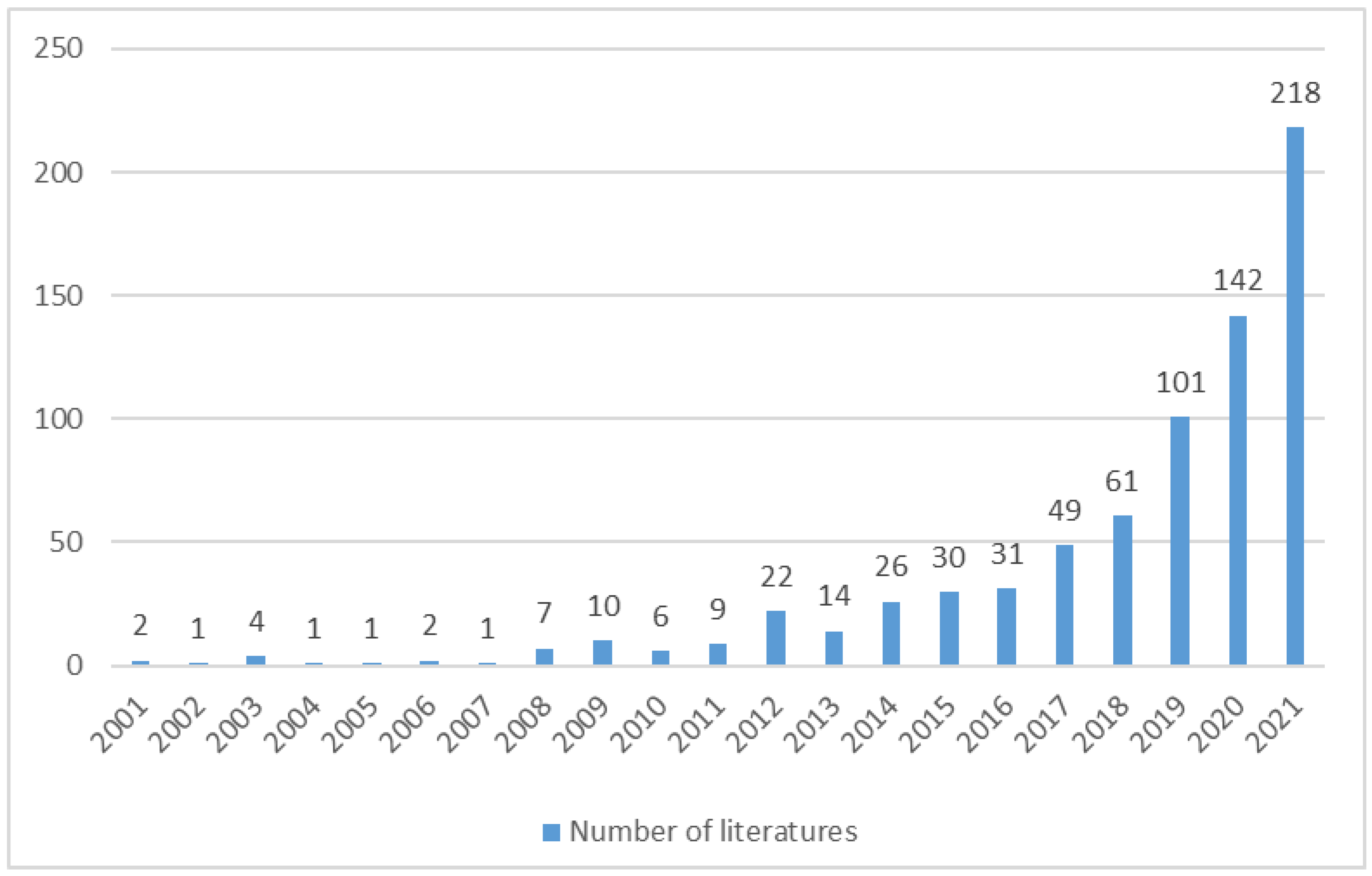
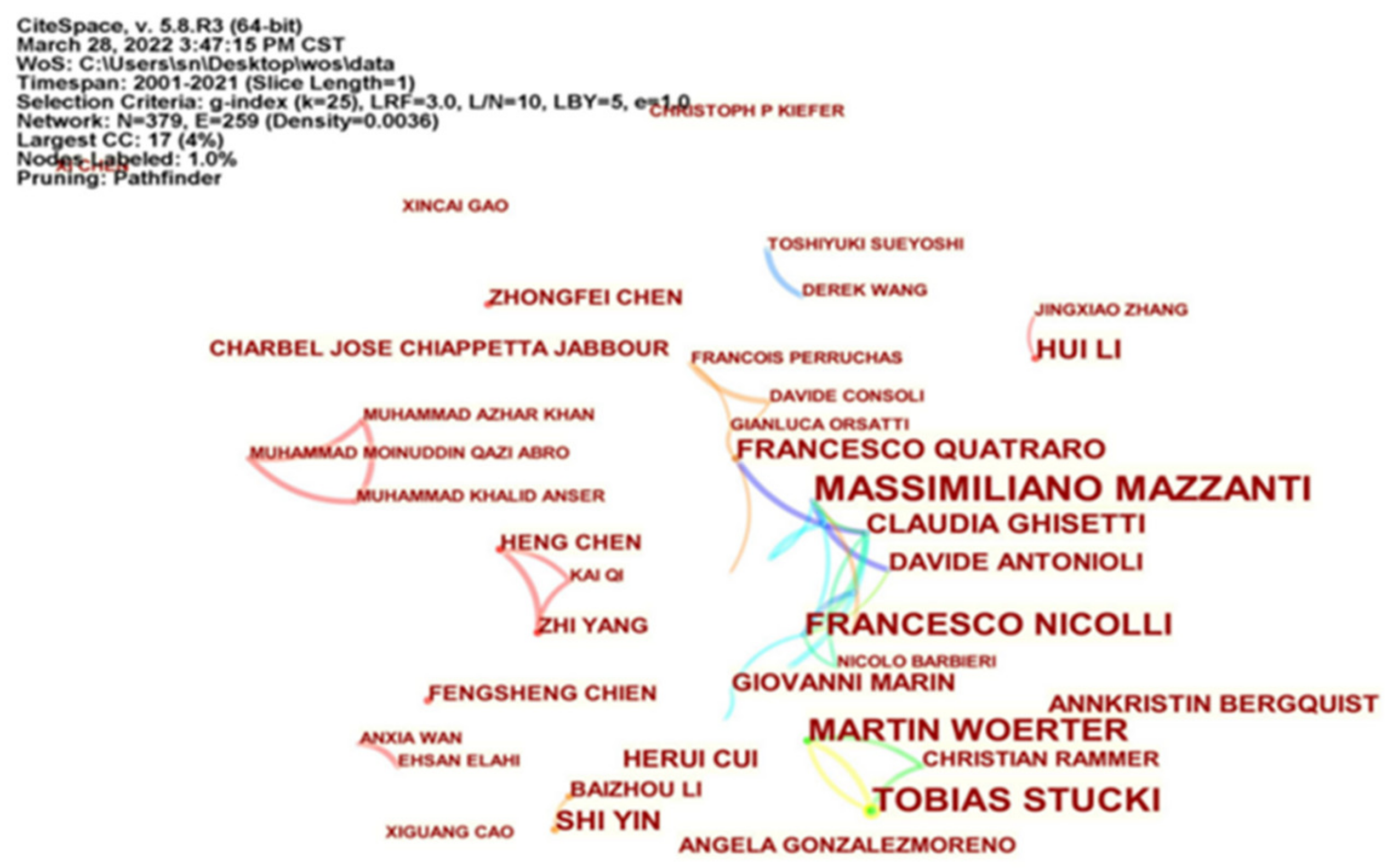
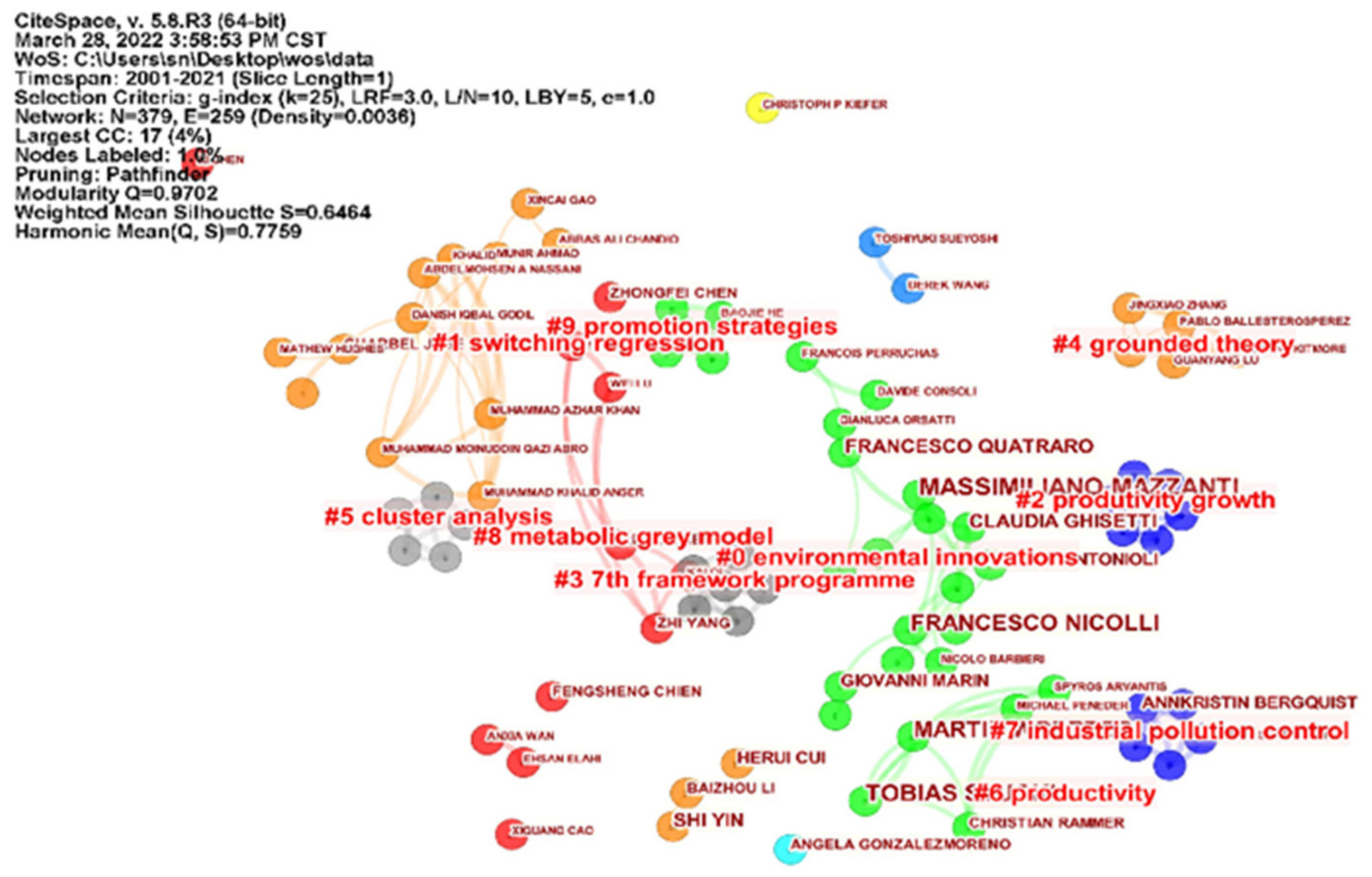
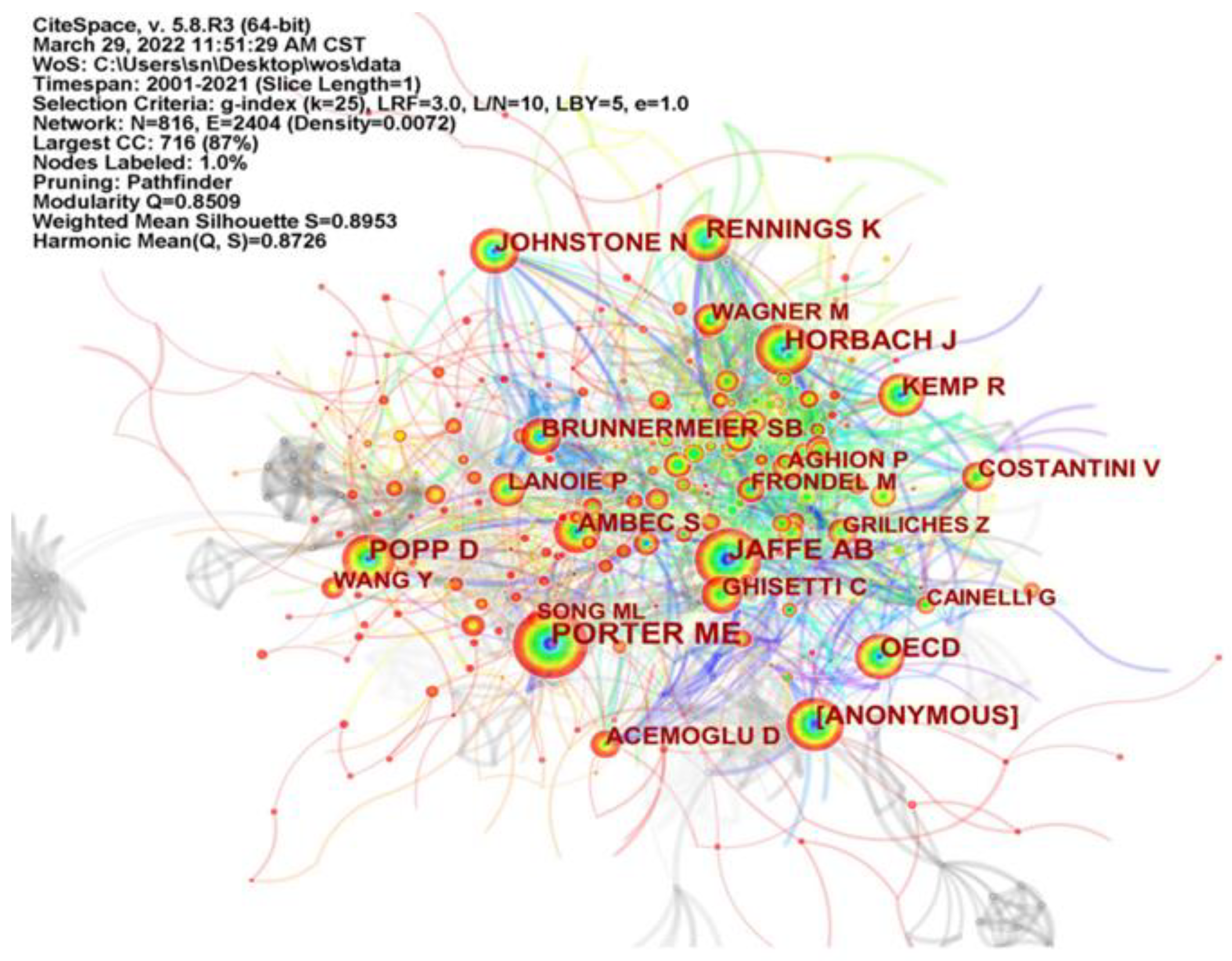
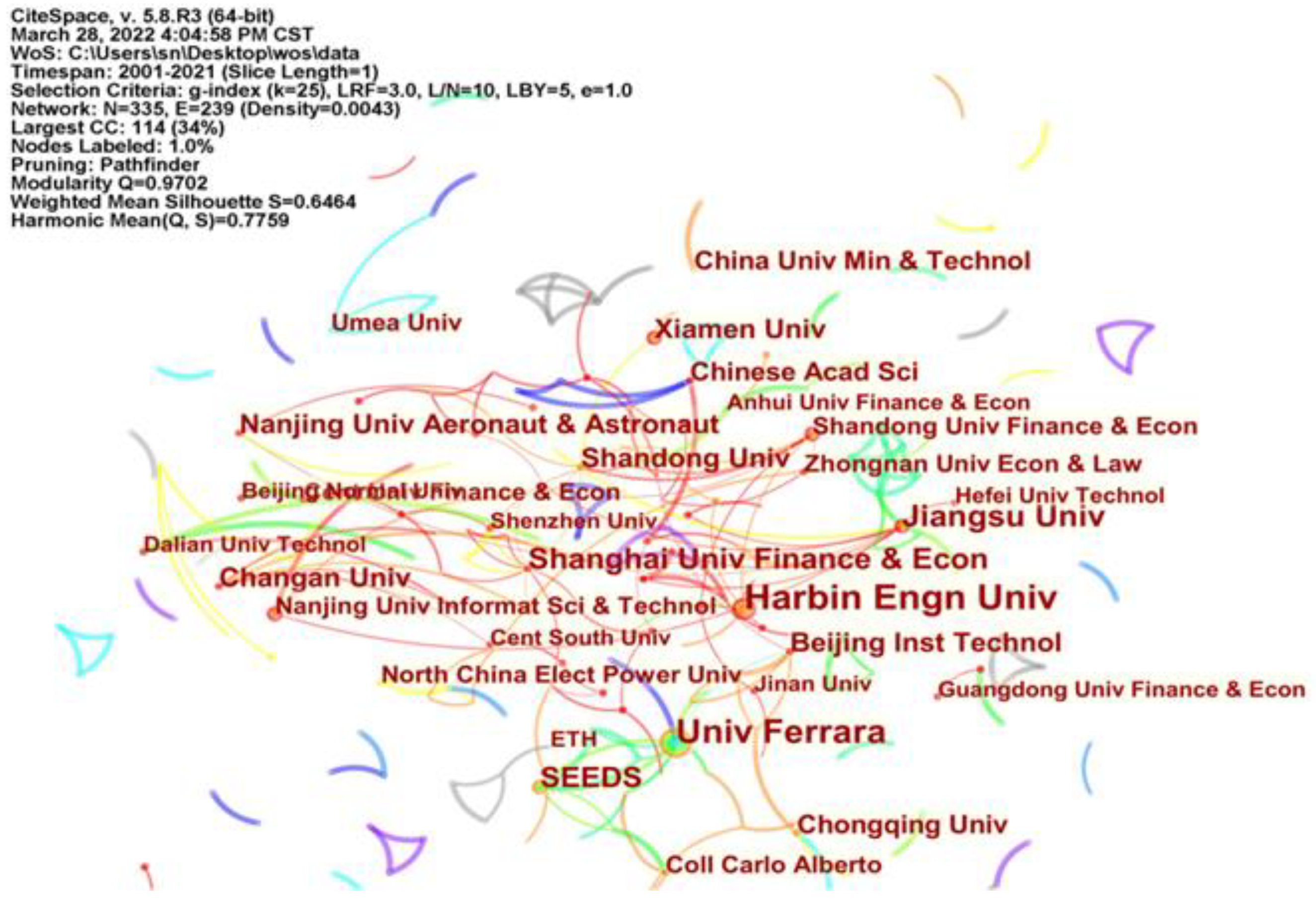
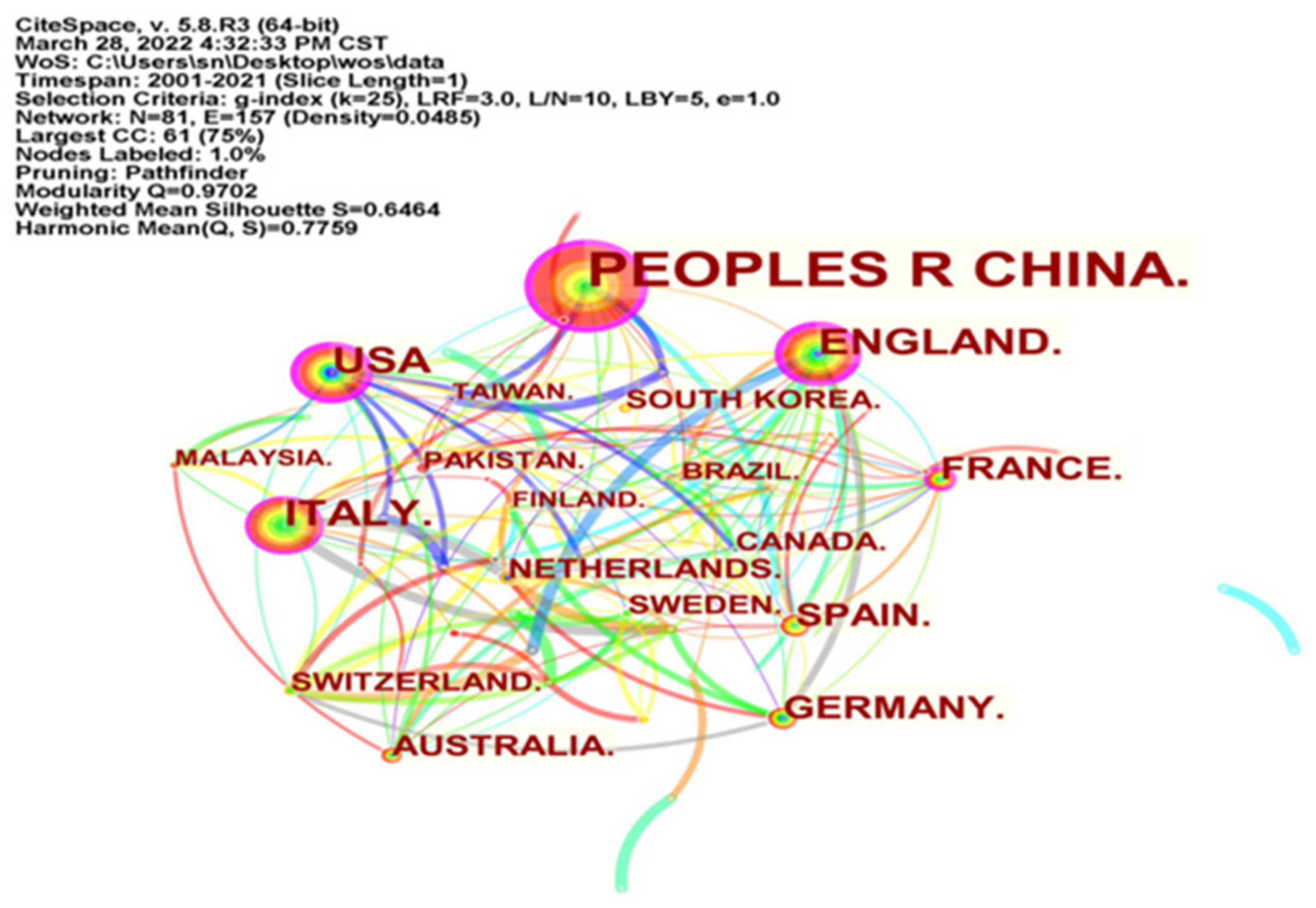
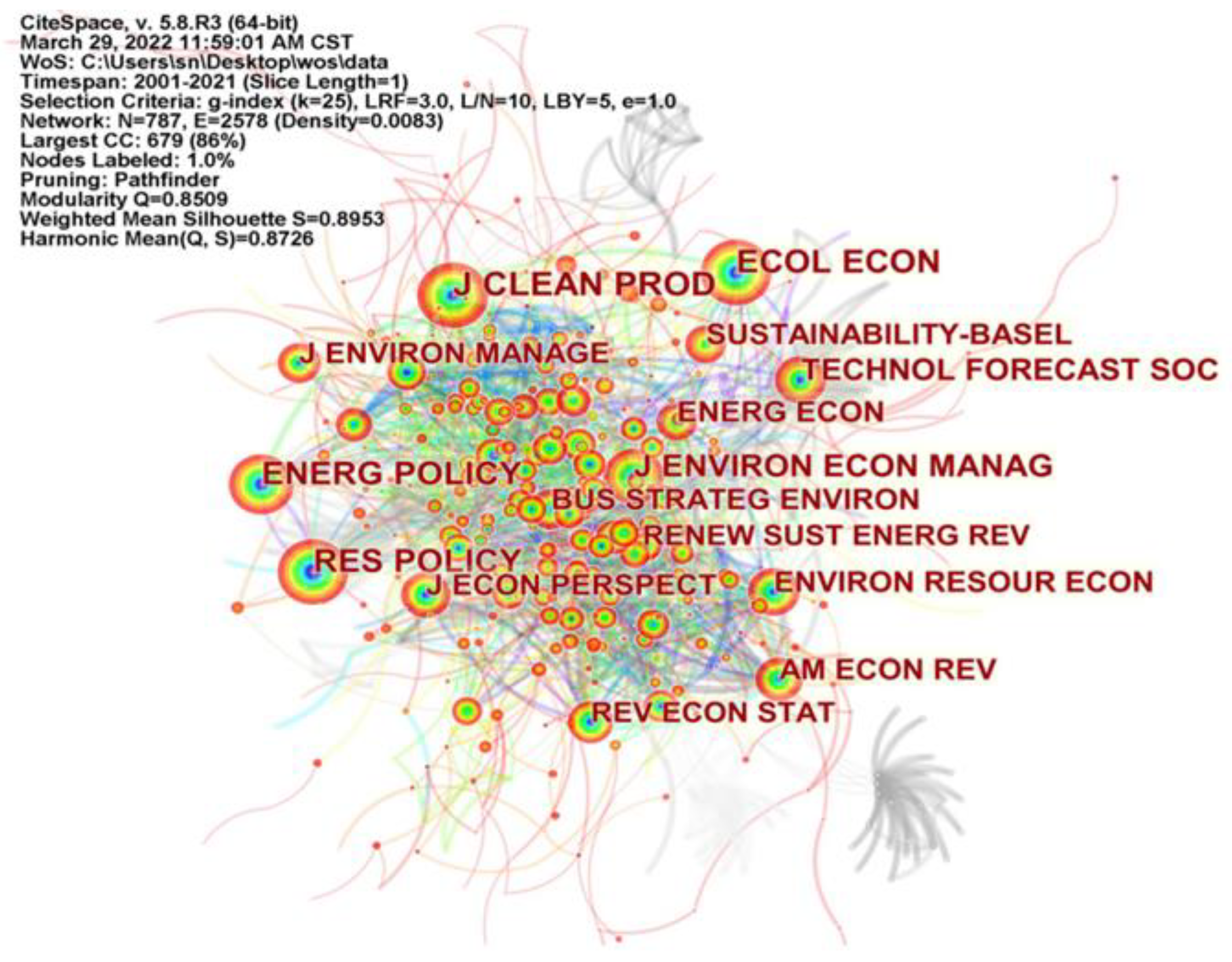
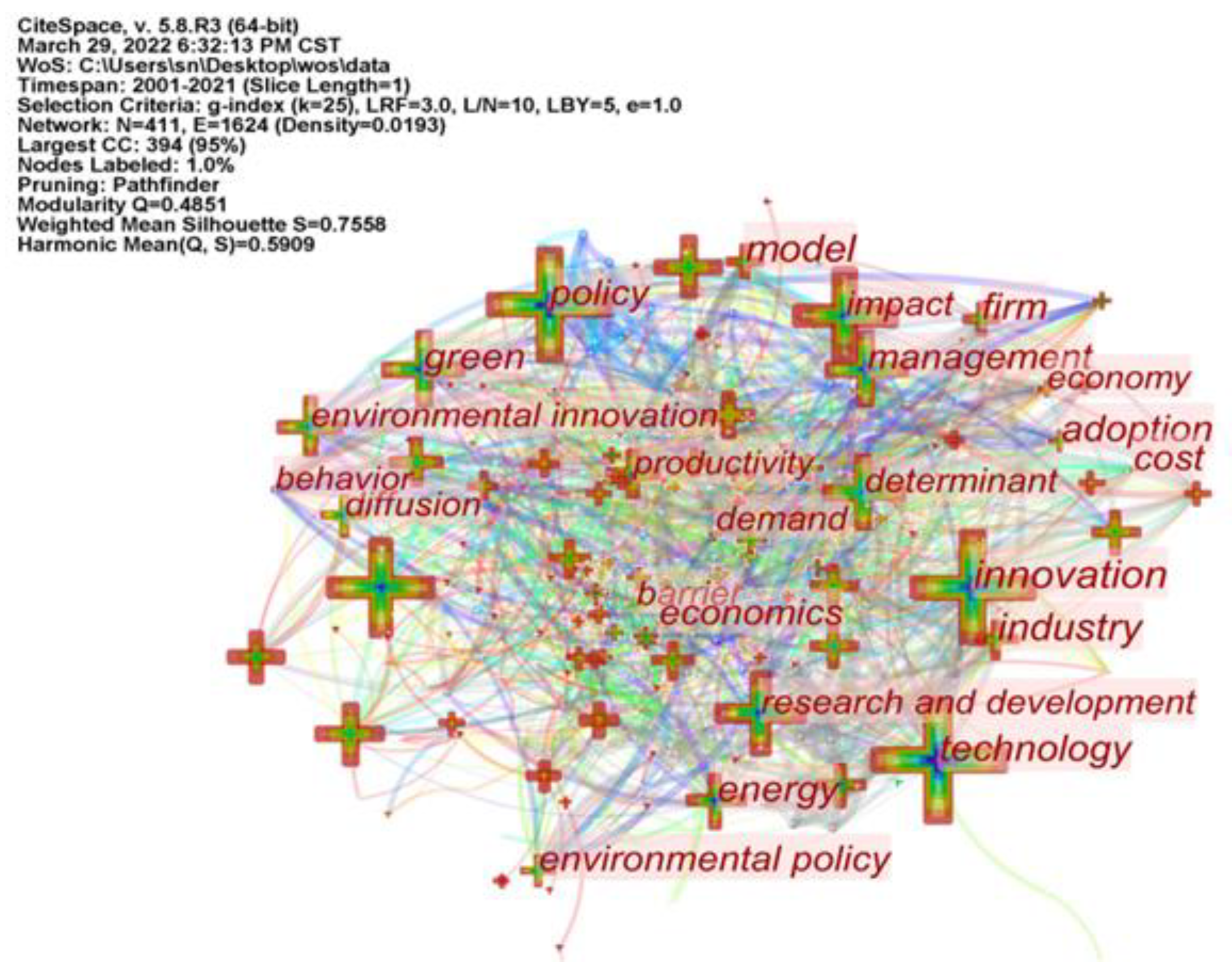
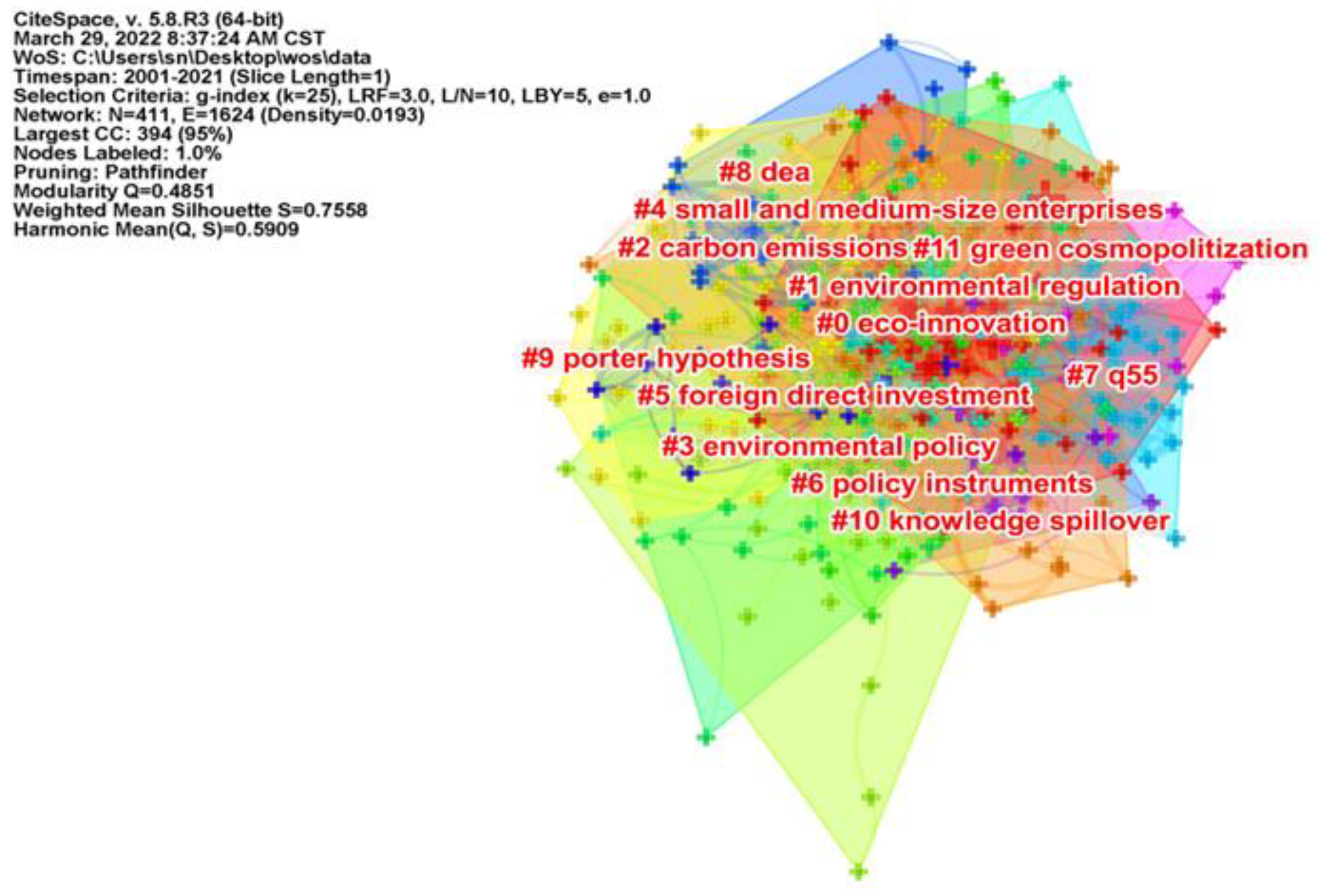
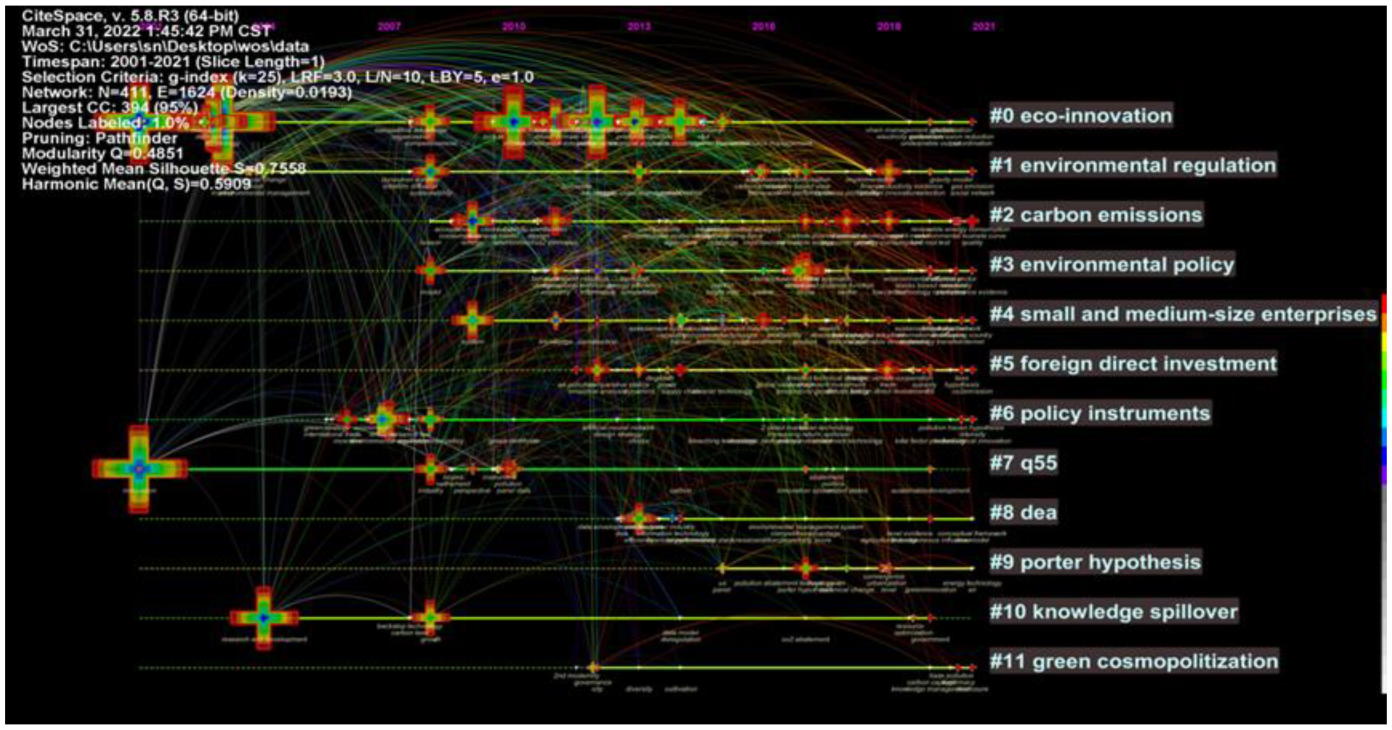
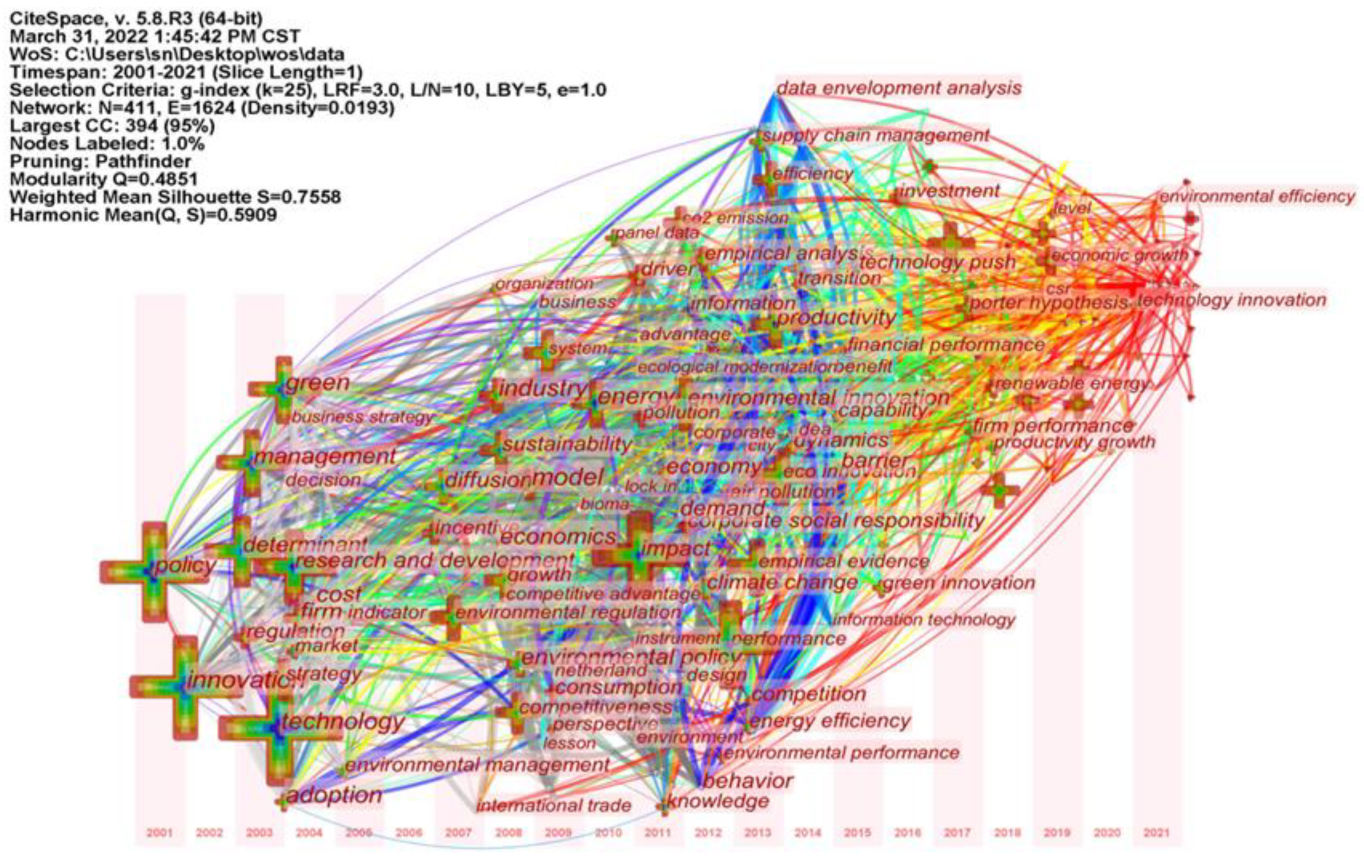
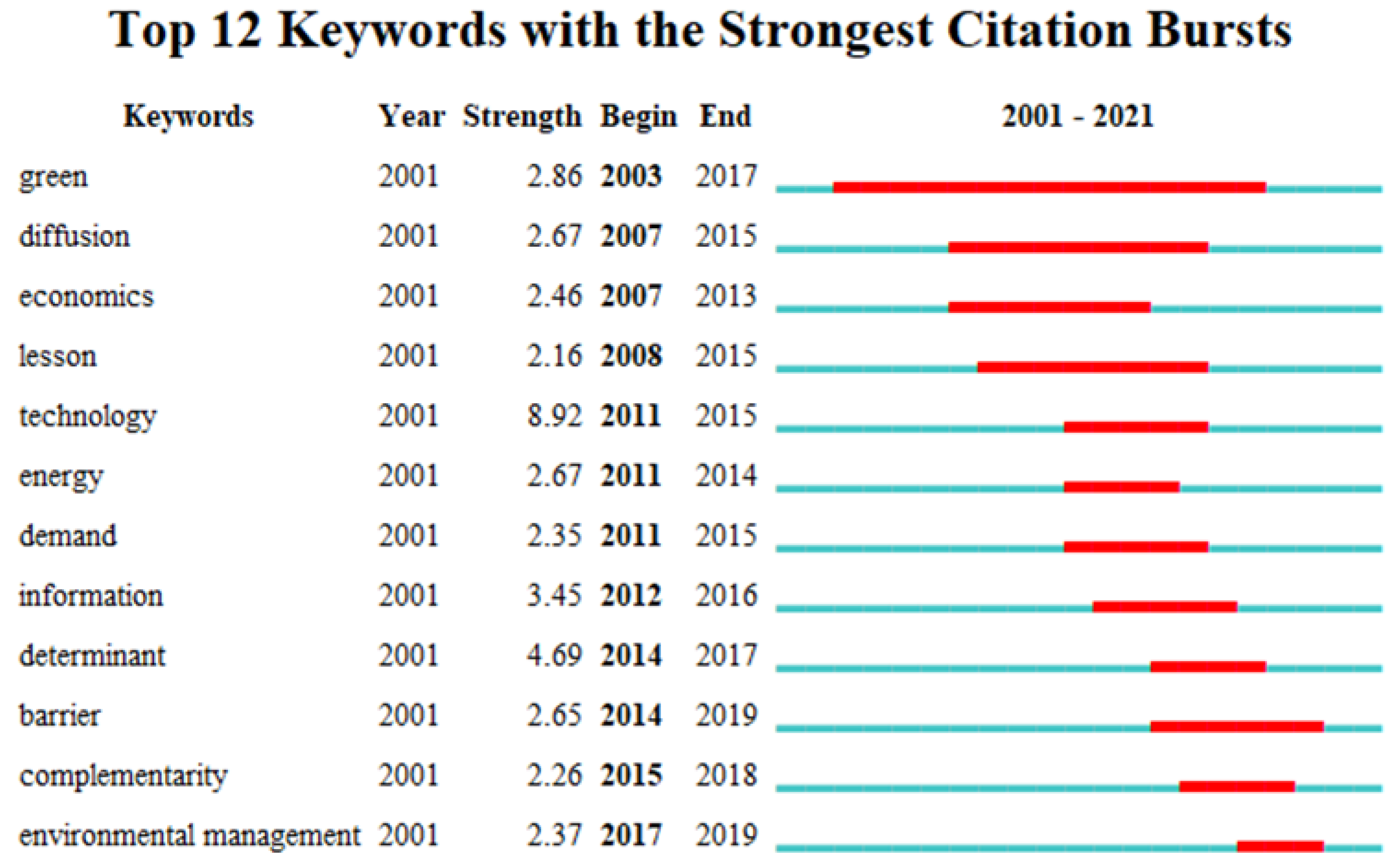
| Retrieval Setting Subjects | Retrieve Settings and Results |
|---|---|
| Database | Science Citation Index Expanded (SCI-EXPANDED) Social Sciences Citation Index (SSCI) |
| Retrieval mode | TS = (environmental regulation or environmental policy) and (green technology innovation or green patent) |
| Type of literature | Article, Review |
| Language type | English |
| Time span | 2001–2021 |
| Retrieval results | 738 papers (695 articles and 43 reviews) |
| Item | Author | Frequency | Item | Author | Frequency |
|---|---|---|---|---|---|
| 1 | Massimiliano Mazzanti | 9 | 6 | Francesco Quatrao | 5 |
| 2 | Tobias Stucki | 8 | 7 | Hui Li | 5 |
| 3 | Francesco Nicolli | 7 | 8 | Claudia Chisetti | 5 |
| 4 | Martin Woerter | 7 | 9 | Herui Cui | 4 |
| 5 | Shi Yin | 5 | 10 | Annkristin Bercquist | 4 |
| Rank | Author | Frequency | Centrality | Rank | Author | Frequency | Centrality |
|---|---|---|---|---|---|---|---|
| 1 | Porter ME | 277 | 0.12 | 7 | OECD | 119 | 0.06 |
| 2 | Jaffe AB | 197 | 0.05 | 8 | Ambec S | 106 | 0.09 |
| 3 | Horbach J | 147 | 0.04 | 9 | Johnstone N | 100 | 0.03 |
| 4 | Popp D | 146 | 0.04 | 10 | Brunnermeier SB | 97 | 0.14 |
| 5 | Anonymous | 131 | 0.04 | 11 | Kemp R | 97 | 0.02 |
| 6 | Rennings K | 128 | 0.02 | 12 | Acemoglu D | 88 | 0.06 |
| Item | Research Institution | Frequency | Item | Research Institution | Frequency |
|---|---|---|---|---|---|
| 1 | Harbin Engn Univ | 18 | 6 | Nanjing Univ Aeronaut & Astronaut | 8 |
| 2 | Univ Ferrara | 15 | 7 | Changan Univ | 8 |
| 3 | Jiangsu Univ | 12 | 8 | Xiamen Univ | 8 |
| 4 | Shanghai Univ Finance &Econ | 11 | 9 | Shandong Univ | 8 |
| 5 | SEEDS | 10 | 10 | Beijing Inst Technol | 8 |
| Rank | Country (Region) | Frequency | Centrality | Rank | Country (Region) | Frequency | Centrality |
|---|---|---|---|---|---|---|---|
| 1 | Peoples R China | 301 | 0.25 | 7 | France | 34 | 0.16 |
| 2 | Italy | 72 | 0.15 | 8 | Australia | 27 | 0.06 |
| 3 | USA | 71 | 0.24 | 9 | Netherlands | 19 | 0.02 |
| 4 | England | 68 | 0.29 | 10 | Switzerlands | 18 | 0.02 |
| 5 | Germany | 37 | 0.02 | 11 | South Korea | 17 | 0.00 |
| 6 | Spain | 34 | 0.09 | 12 | Canada | 17 | 0.00 |
| Rank | Cited Journal | Frequency | Centrality | Impact Factor |
|---|---|---|---|---|
| 1 | Journal of Cleaner Production | 489 | 0.11 | 11.072 |
| 2 | Ecological Economics | 398 | 0.09 | 6.536 |
| 3 | Energy Policy | 381 | 0.06 | 7.576 |
| 4 | Research Policy | 371 | 0.02 | 9.473 |
| 5 | Journal of Environmental Economics and Management | 302 | 0.02 | 5.840 |
| 6 | Technological Forecasting and Social Change | 279 | 0.04 | 10.884 |
| 7 | Environmental & Resource Economics | 236 | 0.04 | 4.955 |
| 8 | American Economic Review | 233 | 0.17 | 11.490 |
| 9 | Journal of Economic Perspectives | 230 | 0.01 | 9.944 |
| 10 | Energy Economics | 226 | 0.02 | 9.252 |
| Item | Keyword | Frequency | Centrality | Item | Keyword | Frequency | Centrality |
|---|---|---|---|---|---|---|---|
| 1 | innovation | 165 | 0.15 | 9 | eco innovation | 81 | 0.03 |
| 2 | impact | 165 | 0.05 | 10 | empirical evidence | 79 | 0.01 |
| 3 | technology | 149 | 0.07 | 11 | green | 76 | 0.05 |
| 4 | performance | 141 | 0.01 | 12 | environmental regulation | 66 | 0.02 |
| 5 | policy | 139 | 0.08 | 13 | productivity | 63 | 0.05 |
| 6 | determinant | 94 | 0.04 | 14 | energy | 60 | 0.11 |
| 7 | research and development | 92 | 0.04 | 15 | environmental innovation | 55 | 0.03 |
| 8 | management | 83 | 0.03 | 16 | china | 50 | 0.01 |
Publisher’s Note: MDPI stays neutral with regard to jurisdictional claims in published maps and institutional affiliations. |
© 2022 by the authors. Licensee MDPI, Basel, Switzerland. This article is an open access article distributed under the terms and conditions of the Creative Commons Attribution (CC BY) license (https://creativecommons.org/licenses/by/4.0/).
Share and Cite
Li, M.; Wang, X.; Wang, Z.; Maqbool, B.; Hussain, A.; Khan, W.A. Bibliometric Analysis of the Research on the Impact of Environmental Regulation on Green Technology Innovation Based on CiteSpace. Int. J. Environ. Res. Public Health 2022, 19, 13273. https://doi.org/10.3390/ijerph192013273
Li M, Wang X, Wang Z, Maqbool B, Hussain A, Khan WA. Bibliometric Analysis of the Research on the Impact of Environmental Regulation on Green Technology Innovation Based on CiteSpace. International Journal of Environmental Research and Public Health. 2022; 19(20):13273. https://doi.org/10.3390/ijerph192013273
Chicago/Turabian StyleLi, Mingxing, Xinxing Wang, Zihao Wang, Babar Maqbool, Abid Hussain, and Waris Ali Khan. 2022. "Bibliometric Analysis of the Research on the Impact of Environmental Regulation on Green Technology Innovation Based on CiteSpace" International Journal of Environmental Research and Public Health 19, no. 20: 13273. https://doi.org/10.3390/ijerph192013273
APA StyleLi, M., Wang, X., Wang, Z., Maqbool, B., Hussain, A., & Khan, W. A. (2022). Bibliometric Analysis of the Research on the Impact of Environmental Regulation on Green Technology Innovation Based on CiteSpace. International Journal of Environmental Research and Public Health, 19(20), 13273. https://doi.org/10.3390/ijerph192013273








